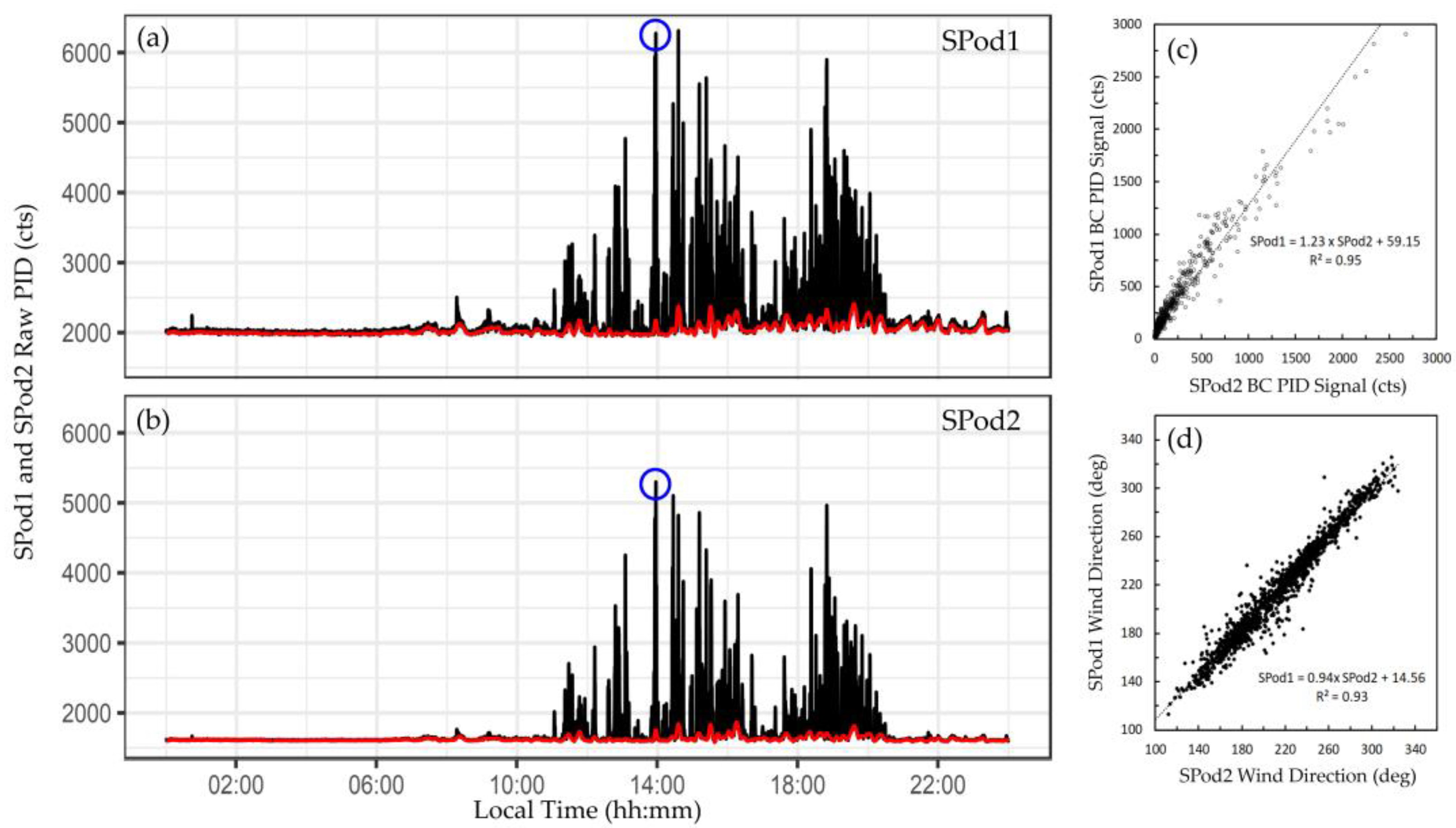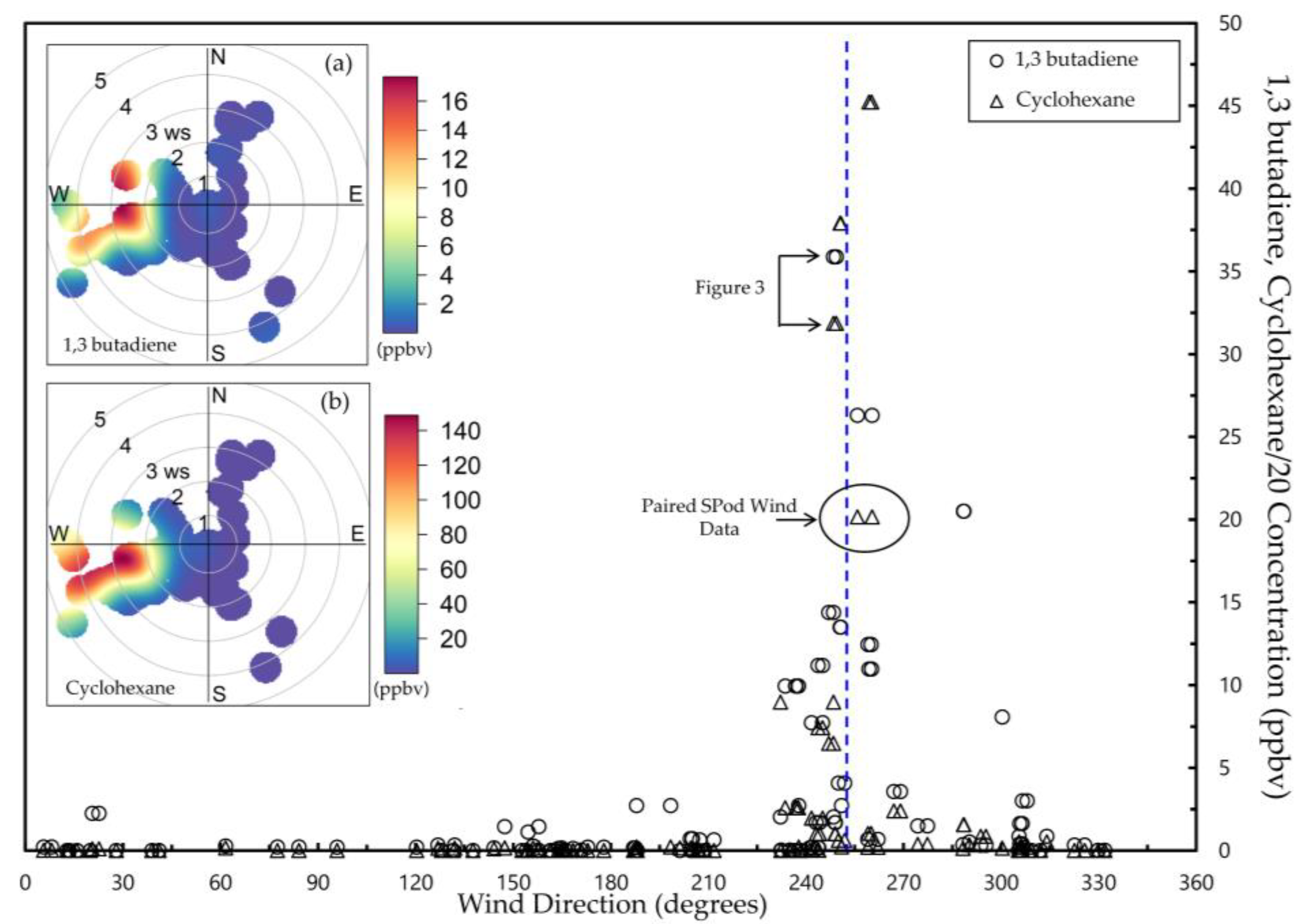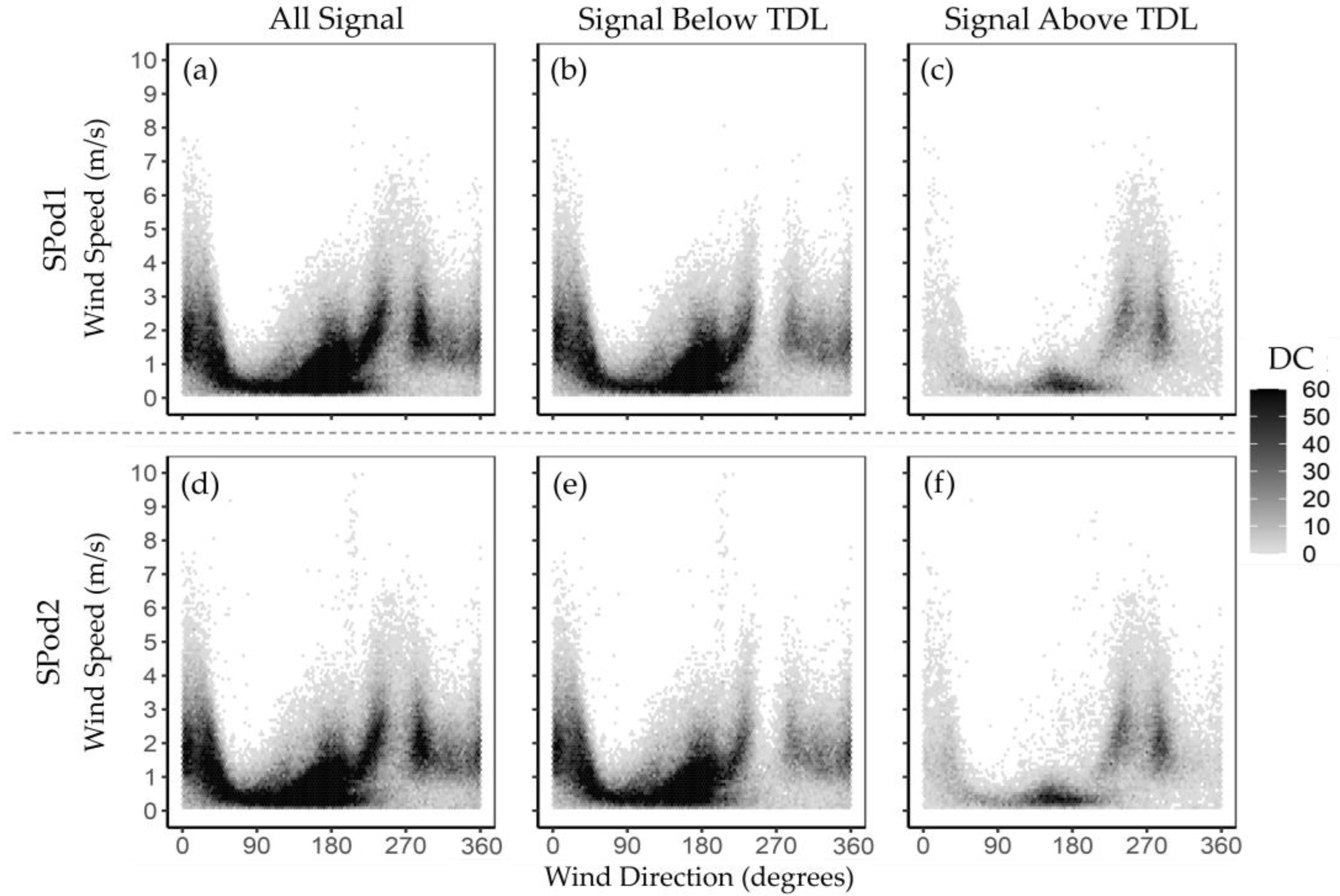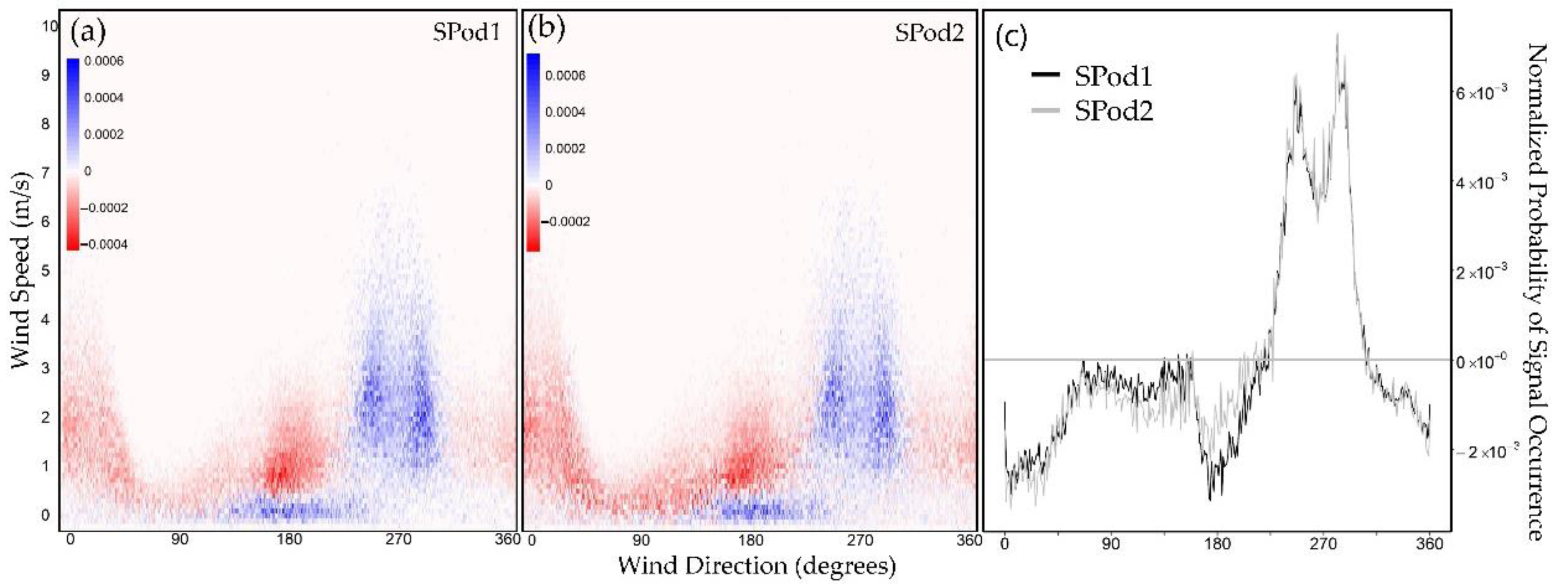Demonstration of VOC Fenceline Sensors and Canister Grab Sampling near Chemical Facilities in Louisville, Kentucky
Abstract
1. Introduction
2. Materials and Methods
2.1. Measurement Site
2.2. EPA SPod Sensors
2.3. Data Analysis
3. Results and Discussion
3.1. Example of Time-Resolved Data from an Elevated Source Signal Day

3.2. CGS Grab Samples and Coincident SPod Data
3.3. Overview of the SPod Dataset
3.4. Source Directional Analysis of Paired SPod Dataset
3.5. Analysis of Detection-Normalized SPod Dataset
4. Conclusions
Supplementary Materials
Author Contributions
Funding
Institutional Review Board Statement
Informed Consent Statement
Data Availability Statement
Acknowledgments
Conflicts of Interest
References
- California. Assembly Bill No. 1647 (AB-1647), Petroleum Refineries: Air Monitoring Systems. 2021. Available online: https://leginfo.legislature.ca.gov/faces/billNavClient.xhtml?bill_id=201720180AB1647 (accessed on 14 January 2022).
- Colorado. General Assembly House Bill No 21-1189 (HB21-1189), Regulate Air Toxics, Concerning Additional Public Health Protections in Relation to the Emission of Air Toxics, and, in Connection Therewith, Making an Appropriation. 2021. Available online: https://leg.colorado.gov/bills/hb21-1189 (accessed on 8 March 2022).
- EPA, U.S. National Emission Standards for Hazardous Air Pollutants from Heat Exchange Systems at Petroleum Refineries—Final Rule; Federal Register 40 CFR Part 63; EPA: Washington, DC, USA, 2013; Volume 78, pp. 37133–37147.
- South Coast Air Quality Management District. Rule 1180. Refinery Fenceline and Community Air Monitoring; South Coast Air Quality Management District: Diamond Bar, USA, 2017.
- Smith, R. Detect Them Before They Get Away: Fenceline Monitoring’s Potential To Improve Fugitive Emissions Management. Tulane Environ. Law J. 2015, 28, 433–453. [Google Scholar]
- Bell, C.S.; Vaughn, T.; Zimmerle, D.; Helmig, D.; Lamb, B. Evaluation of next generation emission measurement technologies under repeatable test protocols. Elem. Sci. Anthr. 2020, 8, 32. [Google Scholar] [CrossRef]
- Dourson, M.L.; Chinkin, L.R.; MacIntosh, D.L.; Finn, J.A.; Brown, K.W.; Reid, S.B.; Martinez, J.M. A case study of potential human health impacts from petroleum coke transfer facilities. J. Air Waste Manag. Assoc. 2016, 66, 1061–1076. [Google Scholar] [CrossRef] [PubMed][Green Version]
- Gai, H.; Beath, J.; Fang, J.; Lou, H.H. Alternative emission monitoring technologies and industrial internet of things–based process monitoring technologies for achieving operational excellence. Curr. Opin. Green Sustain. Chem. 2020, 23, 31–37. [Google Scholar] [CrossRef]
- Pikelnaya, O.; Wimmer, R.; Porter, J.; Tsai, C.; Hamdan, M.; Mukherjee, P.; Prather, M.; Polidori, A. Development of community and fenceline air monitoring network to measure impacts of air toxics on communities near refineries. In Proceedings of the AGU Fall Meeting Abstracts, Virtual Meeting, 7–17 December 2020; p. A175-0008. [Google Scholar]
- Rodríguez, D.J.C.; Benítez, O.G.; Rodríguez, J.R.P.; Acosta, J.B.; Demichela, M. Environmental Monitoring in a Cuban Oil Storage Plant to Characterize the Hydrocarbons Pollution Exposure in the Fence-Line Community; Research Publishing: Singapore, 2021. [Google Scholar]
- Sanchez, N.P.; Saffari, A.; Barczyk, S.; Coleman, B.K.; Naufal, Z.; Rabideau, C.; Pacsi, A.P. Results of Three Years of Ambient Air Monitoring Near a Petroleum Refinery in Richmond, California, USA. Atmosphere 2019, 10, 385. [Google Scholar] [CrossRef]
- Snyder, E.G.; Watkins, T.H.; Solomon, P.A.; Thoma, E.D.; Williams, R.W.; Hagler, G.S.W.; Shelow, D.; Hindin, D.A.; Kilaru, V.J.; Preuss, P.W. The Changing Paradigm of Air Pollution Monitoring. Environ. Sci. Technol. 2013, 47, 11369–11377. [Google Scholar] [CrossRef] [PubMed]
- Thoma, E.; George, I.; Duvall, R.; Wu, T.; Whitaker, D.; Oliver, K.; Mukerjee, S.; Brantley, H.; Spann, J.; Bell, T. Rubbertown Next Generation Emissions Measurement Demonstration Project. Int. J. Environ. Res. Public Health 2019, 16, 2041. [Google Scholar] [CrossRef] [PubMed]
- Cangialosi, F.; Bruno, E.; De Santis, G. Application of Machine Learning for Fenceline Monitoring of Odor Classes and Concentrations at a Wastewater Treatment Plant. Sensors 2021, 21, 4716. [Google Scholar] [CrossRef] [PubMed]
- Kwak, D.; Jeong, J.; Shin, Y.; Lee, N.; Shin, D. Sensor placement optimization for fenceline monitoring of toxic gases considering spatiotemporal risk of the plant-urban interface. J. Taiwan Inst. Chem. Eng. 2021, 130, 103858. [Google Scholar] [CrossRef]
- Thoma, E.D.; Brantley, H.L.; Oliver, K.D.; Whitaker, D.A.; Mukerjee, S.; Mitchell, B.; Wu, T.; Squier, B.; Escobar, E.; Cousett, T.A. South Philadelphia Passive Sampler and Sensor Study. J. Air Waste Manag. Assoc. 2016, 66, 959–970. [Google Scholar] [CrossRef] [PubMed]
- van den Bossche, M.; Rose, N.T.; De Wekker, S.F.J. Potential of a Low-Cost Gas Sensor for Atmospheric Methane Monitoring. Sens. Actuators B Chem. 2017, 238, 501–509. [Google Scholar] [CrossRef]
- Babin, F.; Dufour, P.; Cayer, F.; Gravel, J.-F.Y. UV LED based gas correlation spectrometer of aromatics for the standoff detection of industrials spills and emissions. In Proceedings of the Advanced Environmental, Chemical, and Biological Sensing Technologies XIV, Anaheim, CA, USA, 9–10 April 2017; p. 102150Q. [Google Scholar]
- Cooley, A.; Paris, B.; DeWitt, B.; Lobb, T. Field Evaluation of an Automated-Gas Chromatograph System for Monitoring Volatile Organic Compounds (VOCs) in Ambient Air. In Proceedings of the 2019 Air and Waste Managment Association Air Quality Measurement Methods and Technology Conference, Durham, NC, USA, 2–4 April 2019. [Google Scholar]
- George, I.; Thoma, E.D.; Duvall, D.; Wu, T.; Chou, T.K.A.; Liu, S.; Chung, D.; Deshmukh, P.; Cansler, J.; Cooley, A.; et al. Field demonstration of a novel portable automated gas chromatograph for speciated air toxic VOC measurement in Louisville, KY. In Proceedings of the 2019 Air and Waste Managment Association Air Quality Measurement Methods and Technology Conference, Durham, NC, USA, 2–4 April 2019. [Google Scholar]
- Hellmich, M.; Wiacek, A.; Power, C.N.E.; Mitchell, M.; Ashpole, I. Trace Gas Fluxes Derived from Open-Path FTIR Measurements. In Proceedings of the AGU Fall Meeting Abstracts, Online, 7–17 December 2020; p. A175-0018. [Google Scholar]
- Lucic, G.; Rella, C.; Hoffnagle, J.; Skog, K.; McHale, L. Novel, real-time measurements of VOCs using a Cavity Ring-Down Spectrometer (CRDS). In Proceedings of the EGU General Assembly Conference Abstracts, Online, 4–8 May 2020; p. 20831. [Google Scholar]
- Olaguer, E.P.; Stutz, J.; Erickson, M.H.; Hurlock, S.C.; Cheung, R.; Tsai, C.; Colosimo, S.F.; Festa, J.; Wijesinghe, A.; Neish, B.S. Real time measurement of transient event emissions of air toxics by tomographic remote sensing in tandem with mobile monitoring. Atmos. Environ. 2017, 150, 220–228. [Google Scholar] [CrossRef]
- Smith, J.N.; Keil, A.; Likens, J.; Noll, R.J.; Cooks, R.G. Facility monitoring of toxic industrial compounds in air using an automated, fieldable, miniature mass spectrometer. Analyst 2010, 135, 994–1003. [Google Scholar] [CrossRef] [PubMed]
- Stutz, J.; Pikelnaya, O. Demonstration of Remote Sensing Fenceline Monitoring Methods at Oil Refineries and Ports; Report prepared for South Coast Air Quality Management District, Diamond Bar, CA; University of California Los Angeles: Los Angeles, CA, USA, 2015. [Google Scholar]
- Zemek, P.G. Optical Remote Sensing for Fence-Line Monitoring using Open-Path Quantum Cascade Laser (QCL) mono-static system for multiple target compounds in the Mid IR 7–13 um (Fingerprint) region. In Proceedings of the AGU Fall Meeting Abstracts, New Orleans, LA, USA, 11–15 December 2017; p. A43A-2430. [Google Scholar]
- Ion Science PID Response Factors. 22 January 2018; Version 1.10: [Technical/Application Article 02]. Available online: https://www.fieldenvironmental.com/assets/files/Literature/Ion-Science-PID-Response-Factors.pdf (accessed on 18 February 2022).
- United States Environmental Protection Agency. Hazardous Air Pollutants. Available online: https://www.epa.gov/haps (accessed on 18 February 2022).
- Ion Science USA. High Sensitivity VOC Gas Sensor. 2022. Available online: https://ionscience.com/usa/products/minipid-2-hs-high-sensitivity-gas-sensor/#technical-specification (accessed on 18 February 2022).
- Baseline® piD-TECH® eVx™ OEM Photoionization Sensors. Ametek Mocon, Inc., 2020. Available online: https://www.ametekmocon.com/-/media/ametekmocon/mediapreview/brochures/baseline-product-brochures/evx--baseline-oem-photoionization-sensor-family--product-brochure/pb-d045-1_baseline-pid-tech-evx-brochure_web.pdf?la=en&revision=b762ed1c-991d-43ce-9dd2-f9a240a7c99f?download=1 (accessed on 18 February 2022).
- MacDonald, M.; Smith, C.; Thoma, E.; George, I.; Duvall, R.; Deshmukh, P.; Scott, A. Fenceline and Community Sensor Applications and Comparisons. In Proceedings of the Air Sensors International Conference, 2021 Virtual Series, Online, 18 May 2021; Available online: https://www.youtube.com/watch?v=ACFm8-WhMRU (accessed on 18 February 2022).
- EPA, U.S. Compendium Method TO-15,Determination of Volatile Organic Compounds (VOCs) in Air Collected in Specially-Prepared Canisters and Analyzed by Gas Chromatography/Mass Spectrometry (GC/MS) in Compendium of Methods for the Determination of Toxic Organic Compounds in Ambient Air; Center for Environmental Research Information, Office of Research and Development, U.S. EPA: Cincinnati, OH, USA, 1999.
- R Core Team. R: A Language and Environment for Statistical Computing; R Foundation for Statistical Computing: Vienna, Austria, 2019. [Google Scholar]
- Carslaw, D.C.; Ropkins, K. Openair—An R package for air quality data analysis. In Environmental Modelling & Software; Elsevier: Amsterdam, The Netherlands, 2012. [Google Scholar]
- Brantley, H.; Guinness, J.; Chi, E. Detrendr: Quantile Trend Filtering, in Baseline Drift Estimation for Air Quality Data Using Quantile Trend Filtering. 2020. Available online: https://arxiv.org/pdf/1904.10582.pdf (accessed on 18 February 2022).







| Data Summary | SPod1 | SPod2 |
|---|---|---|
| All Available 5-min Periods in Time Frame [Days] | 167,328 [581] | |
| Final QA-valid 5-min Periods [Study Days Represented] | 131,120 [476] | 143,242 [521] |
| Percentage of QA-valid 5-min Periods [Percentage of Study Days Represented] (%) | 78.4 [81.9] | 85.6 [89.7] |
| Percentage of QA-valid Data > TDL (%) | 21.2 | 25.6 |
| Paired 5-min Periods [Study Days Represented] | 120,656 [445] | |
| Percentage of Paired 5-min Periods [Percentage of Study Days Represented] (%) | 72.1 [76.6] | |
| Percentage of Paired Data > TDL (%) | 20.7 | 25.3 |
| Average [Median] of Paired Data Daily TDL (cts) | 53.2 [46.7] | 12.8 [9.3] |
| Minimum [Maximum] of Paired Data Daily TDL (cts) | 22.8 [425.1] | 4.1 [75.9] |
| All Wind Speeds | ||||
|---|---|---|---|---|
| Quadrant (SPod1, SPod2) | Total 5-min Periods | Percentage of Total (%) | Percentage of Total > TDL (%) 1 | Percentage in Each Quadrant > TDL (%) 2 |
| <west> | 27,216 | 22.6 | 53.0 | 48.5 |
| <north> | 28,344 | 23.5 | 9.2 | 8.0 |
| <east> | 16,655 | 13.8 | 8.2 | 12.3 |
| <south> | 48,441 | 40.1 | 29.7 | 15.3 |
| <west> | 26,352 | 21.8 | 48.5 | 56.3 |
| <north> | 30,140 | 25.0 | 14.0 | 14.2 |
| <east> | 19,782 | 16.4 | 10.6 | 16.4 |
| <south> | 44,382 | 36.8 | 26.8 | 18.5 |
| Wind Speeds > 1.0 m/s | ||||
| Quadrant (SPod1, SPod2) | Total 5-min Periods | Percentage of Total (%) | Percentage of Total > TDL (%)1 | Percentage in Each Quadrant > TDL (%)2 |
| <west> | 23,267 | 33.1 | 81.7 | 50.7 |
| <north> | 22,575 | 32.2 | 9.8 | 6.3 |
| <east> | 3526 | 5.0 | 0.7 | 2.9 |
| <south> | 20,844 | 29.7 | 7.8 | 5.4 |
| <west> | 22,337 | 32.6 | 73.8 | 59.1 |
| <north> | 23,612 | 34.4 | 16.6 | 12.6 |
| <east> | 3703 | 5.4 | 1.0 | 4.6 |
| <south> | 18,912 | 27.6 | 8.6 | 8.1 |
Publisher’s Note: MDPI stays neutral with regard to jurisdictional claims in published maps and institutional affiliations. |
© 2022 by the authors. Licensee MDPI, Basel, Switzerland. This article is an open access article distributed under the terms and conditions of the Creative Commons Attribution (CC BY) license (https://creativecommons.org/licenses/by/4.0/).
Share and Cite
MacDonald, M.; Thoma, E.; George, I.; Duvall, R. Demonstration of VOC Fenceline Sensors and Canister Grab Sampling near Chemical Facilities in Louisville, Kentucky. Sensors 2022, 22, 3480. https://doi.org/10.3390/s22093480
MacDonald M, Thoma E, George I, Duvall R. Demonstration of VOC Fenceline Sensors and Canister Grab Sampling near Chemical Facilities in Louisville, Kentucky. Sensors. 2022; 22(9):3480. https://doi.org/10.3390/s22093480
Chicago/Turabian StyleMacDonald, Megan, Eben Thoma, Ingrid George, and Rachelle Duvall. 2022. "Demonstration of VOC Fenceline Sensors and Canister Grab Sampling near Chemical Facilities in Louisville, Kentucky" Sensors 22, no. 9: 3480. https://doi.org/10.3390/s22093480
APA StyleMacDonald, M., Thoma, E., George, I., & Duvall, R. (2022). Demonstration of VOC Fenceline Sensors and Canister Grab Sampling near Chemical Facilities in Louisville, Kentucky. Sensors, 22(9), 3480. https://doi.org/10.3390/s22093480







